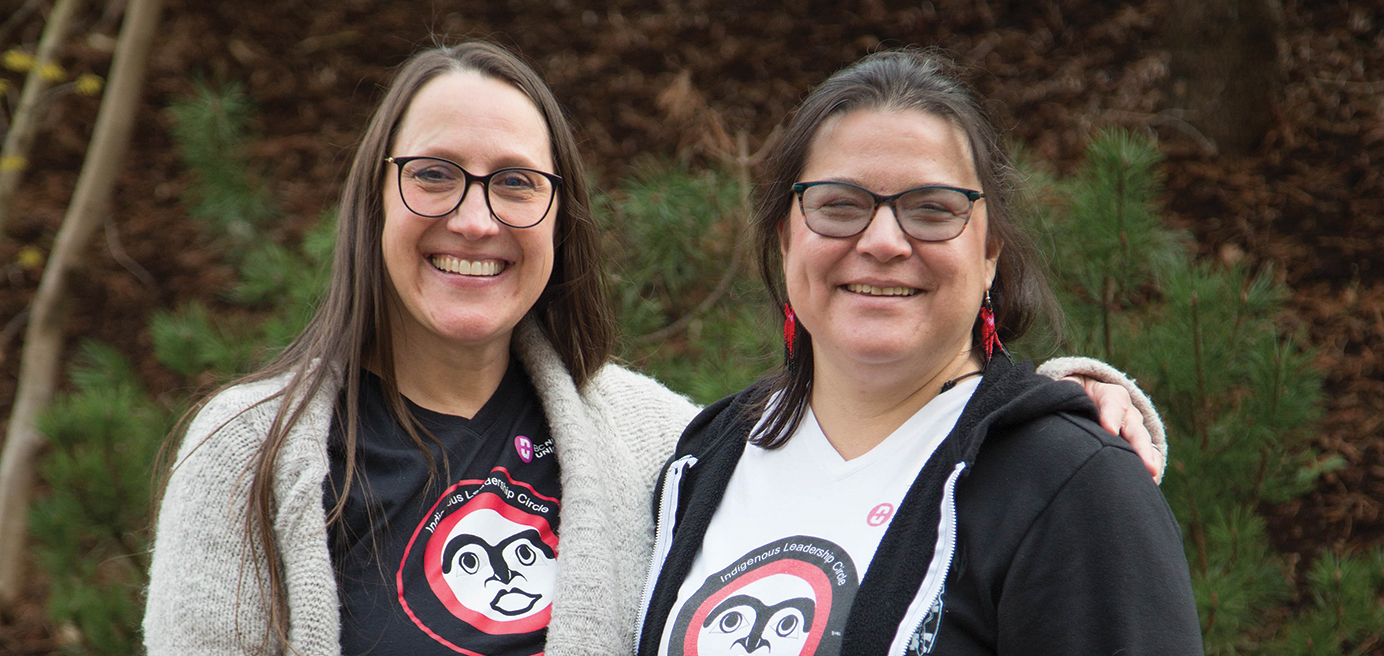 Human Rights and Equity Q&A
Human Rights and Equity Q&A

In 2015, the Truth and Reconciliation Commission of Canada issued its landmark report Honouring the Truth, Reconciling for the Future, which detailed the historical injustices Indigenous people in Canada experienced through the residential school system. The commission’s 94 calls to action for governments, organizations and individuals also offered a roadmap to address the devastating legacy of residential schools still felt by Indigenous people and communities to this day.
Following the report, BCNU endorsed the calls to action and committed to advancing reconciliation with Indigenous peoples, both within the communities it serves and within its own membership. A resolution brought forward by the BCNU Indigenous Leadership Circle to create the BCNU Truth and Reconciliation Committee (TRC) was passed at the union’s annual convention in 2019. This committee has a mandate to lead BCNU’s reconciliation efforts.
Indigenous members Monique Pat and Michelle Martinson have been on the TRC since its inception. Both are members of the BCNU Indigenous Leadership Circle, and have been active union advocates since they began their nursing careers in 2007 and 2008 respectively.
Martinson has worked in many areas of nursing, including seniors’ outreach, long-term care and palliative care. Pat has spent most of her career working in Indigenous health, providing home care, and HIV/AIDS and diabetes outreach.
BCNU sat down with Martinson and Pat to learn more about their role on the TRC and their advocacy work throughout the years.
UPDATE The BCNU Truth and Reconciliation Committee has two BCNU Indigenous Leadership Circle representatives who serve as regular committee members. How did you become involved with the Indigenous Leadership Circle and how has it developed over time?
MARTINSON The ILC was a place for First Nations, Métis and Inuit nurses to share their experiences and to provide support to each other. Originally called the Aboriginal Leadership Circle, I first met with the group when I was invited to a meeting during convention. Over the years, we have evolved into a group that I feel focuses more on advocacy and education.
PAT I was invited to join the ILC by the Indigenous health liaison in Port Hardy, and participated as an alternate regional representative at first. We would discuss what it was like being an Indigenous nurse in the health-care system and then began focusing on missing and murdered Indigenous women and girls, promoting Orange Shirt Day, and had dreams of decolonizing and indigenizing the union. The influence and guidance of Elder nurses throughout the years has been invaluable to the work we have done and continue to do. BCNU human rights and equity officer Hanif Karim has been a strong supporter of the ILC through the years, and that highlights how crucial it is to have strong allies who understand the realities of what’s going on in Canada.
UPDATE Tell us about how BCNU’s Truth and Reconciliation Committee came into existence.
PAT The committee was formally struck in 2020, following the convention resolution that created it a year earlier, and we have been meeting ever since.
MARTINSON Prior to this resolution, I had never seen such a strong show of support for Indigenous people within the union. Silence and secrecy perpetuate oppression, and that was the reality for so long when it came to Canada’s history and relationship with Indigenous peoples. Seeing the support of the membership to create this committee was uplifting. It felt like there was an unearthing, and people finally understood. We felt seen. Bravery is what is needed to have uncomfortable conversations and we saw a lot of bravery that day.
UPDATE What have you learned about yourself from working on the Truth and Reconciliation Committee?
MARTINSON I learned that I have a voice and that the Indigenous perspective I bring forward can influence change. While this work has been uplifting and inspiring, it has also been painful, uncomfortable and difficult to engage in at times. Through those experiences I learned how incredibly resilient and strong I am.
PAT At our first meeting, we recognized that there are no shortcuts to this work and we must go the distance when it comes to reconciliation. I have thought about my mother’s influence on me, my grandparents and great grandparents – and I think about how colonization has affected all my family. I have gotten to learn a lot more about my mom and the amazing work she did throughout her life.
There was a time when I was afraid to speak in public, and now I truly feel I have a voice. I rely on the guidance of my ancestors and other Indigenous leaders to amplify my voice. This got me thinking about how we can do this work together and I realized that we must do it together. There is always a way through despite the challenges, but we must find this way through together no matter how uncomfortable or difficult it is.
UPDATE What is a union’s role in advancing principles of truth and reconciliation?
MARTINSON Reconciliation requires political will, joint leadership, trust building, accountability and transparency, as well as a substantial investment of resources, as outlined in the Truth and Reconciliation Commission calls to action document.
PAT The role of the union is to be an ally with Indigenous members and create a safe environment for this work to be done. It should make the ILC strong for Indigenous nurses and advocate for justice with us.
UPDATE Cultural safety is identified as a mechanism to address Indigenous-specific racism in health care – which was identified in the provincial government’s 2019 report In Plain Sight: Addressing Indigenous-specific Racism and Discrimination in BC Health Care. The need for cultural safety has also been acknowledged by the BC College of Nurses and Midwives through its newest nursing practice standard on Indigenous cultural safety, cultural humility and anti-racism. What is cultural safety to you and how can its principles be embodied by the union?
PAT Practicing cultural safety is more than learning about culture. Rather, it is about relational practice and building relationships. The union has done a lot of great work to date and there is room for improvement always. Hiring in-house cultural safety facilitators who understand the deep methodology of these principles would be a step in the right direction. It would be great for this to extend to the regions as well.
It’s important for cultural safety to be prioritized within the regions and align with provincial work. The nursing college’s practice standard focused on cultural safety is a great opportunity to advance this work. Creating a union education program outlining the practice standard’s elements would be a worthwhile endeavor.
MARTINSON Above all, there must be an understanding of the importance of embodying the principles of cultural safety. This must be in every area and apparent in every action, policy and statement. The union can continue to build trust and advocate for social justice within the organization. Cultural safety can be embodied by showing respect to the membership, and reflecting and considering how actions may affect membership.
UPDATE What are your hopes for the future of the Truth and Reconciliation Committee and BCNU members?
MARTINSON I would like to see the principles of this committee embedded into the fabric of the union – in policies, in procedures, in culture, in everything we do. It is important for Indigenous members to be engaged and integrated in this work, so I would like to see that continue.
I’m hoping we can continue to represent First Nations, Métis and Inuit members with the support and dedication of the union leadership. I’d like to see the fruits of this committee encourage allies to act in solidarity with us and take action in the face of injustice when it arises. I hope we can continue to feel safe to explore this work together and that members uphold the principles of this work. I’m also hoping that we continue to have allies, and that the union does this work in solidarity with Indigenous peoples and with Indigenous members.
PAT I’m hoping BCNU contemplates its role in advocating for and supporting the implementation of the Truth and Reconciliation Commission’s 94 calls to action – specifically numbers 18 to 24, which are focused on health care. I’d like to see more Indigenous staff hired and a new HRE staff role dedicated to reconciliation work. I’d like to see the committee work with Indigenous advocates like Cindy Blackstock to advance initiatives. I would like to see the nursing college’s practice standard widely circulated and the UN Declaration on the Rights of Indigenous People implemented. I am hoping we can highlight and promote Joyce’s Principle* to ensure First Nations, Inuit and Métis have the right to culturally safe health care free of racism or discrimination, no matter their circumstances or where they live.
Finally, I’d love to see recruitment, retention, and support of more young Indigenous members and other health-care professionals. What I learned throughout my journey from my mother and other Indigenous activists is that all the work that we do is done with the future generations in mind, while relying on our ancestors to guide the way and trailblazers who continue to pave the way. Meaningful reconciliation work by its nature will benefit future generations of BCNU members, health-care professionals and communities.
*Joyce Echaquan, an Atikamekw woman, was admitted to a Quebec hospital for severe stomach pain in September 2020. She posted a live video on Facebook of nurses taunting her with racial jibes moments before she died. Joyce’s Principle aims to guarantee all Indigenous people the right of equitable access, without any discrimination, to all social and health services, as well as the right to enjoy the best possible physical, mental, emotional and spiritual health. Joyce’s Principle requires the recognition and respect of Indigenous people’s traditional and living knowledge in all aspects of health.
UPDATE (Spring 2023)

